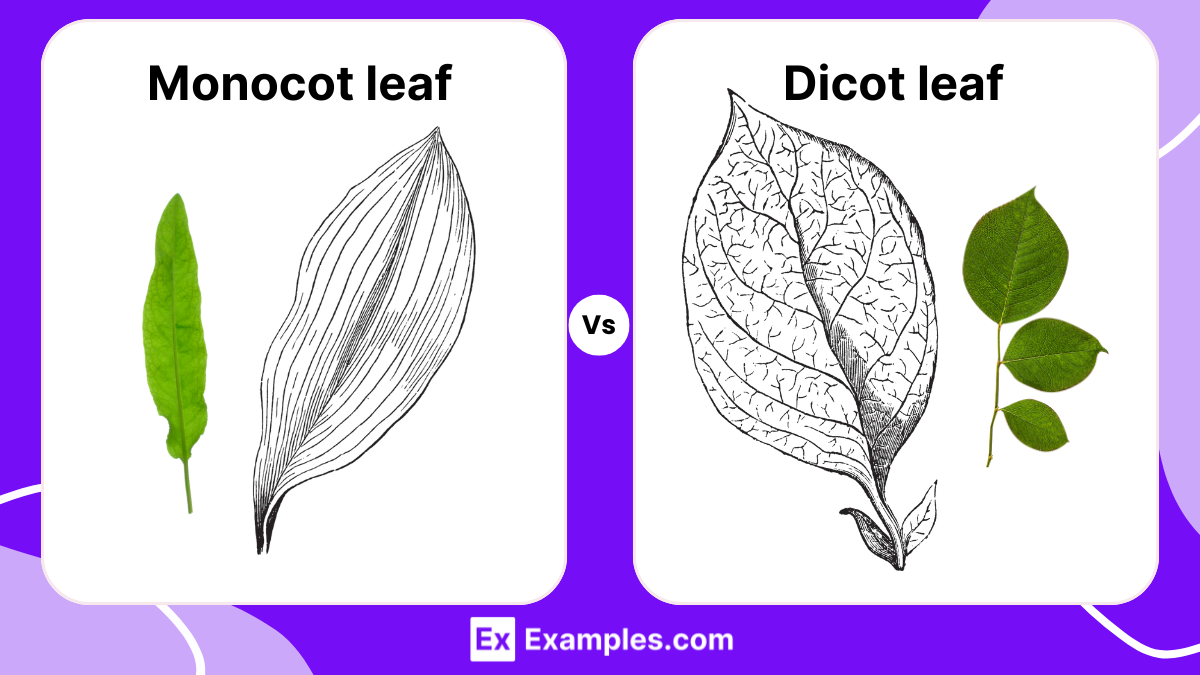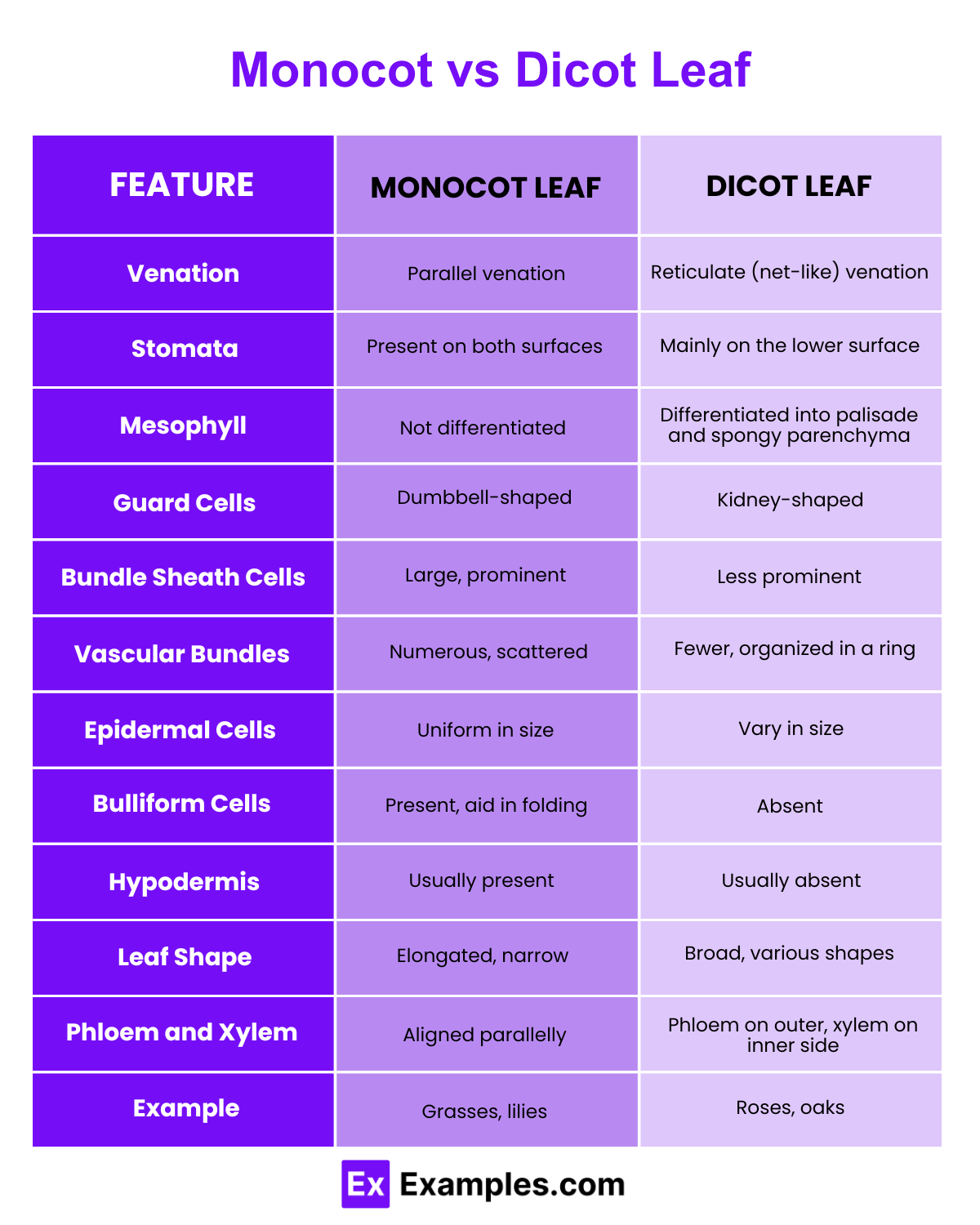What is the primary characteristic that differentiates monocot and dicot leaves?
The number of leaf veins
The presence of chlorophyll
The pattern of venation
The thickness of the leaf


Leaves are crucial for plant survival and play a significant role in photosynthesis, gas exchange, and transpiration. Monocot and dicot leaves exhibit distinct structural differences that reflect their evolutionary adaptations. Monocots, like grasses and lilies, have leaves with parallel veins and uniform vascular bundles. Dicots, such as roses and oaks, feature leaves with a network of branching veins and scattered vascular bundles. Understanding these differences helps in identifying plant species and provides insights into their growth patterns and ecological roles. This article explores the key differences between monocot and dicot leaves, highlighting their unique features and functions.
A monocot leaf is a type of leaf found in monocotyledonous plants, which are a group of flowering plants with a single seed leaf (cotyledon) in their seeds. These leaves have specific structural and functional characteristics that set them apart from dicot leaves. Understanding these features is essential for identifying and studying monocot plants.
A dicot leaf is a type of leaf found in dicotyledonous plants, which are a group of flowering plants with two seed leaves (cotyledons) in their seeds. These leaves exhibit distinct structural and functional characteristics that differentiate them from monocot leaves. Understanding these features is essential for identifying and studying dicot plants.

| Feature | Monocot Leaf | Dicot Leaf |
|---|---|---|
| Vein Arrangement | Parallel venation | Reticulate venation |
| Stomata Distribution | Stomata on both surfaces equally | Stomata more on lower surface |
| Mesophyll | Undifferentiated mesophyll | Differentiated into palisade and spongy mesophyll |
| Bulliform Cells | Present, aiding in leaf rolling | Absent |
| Epidermal Layers | Single layer with uniform cells | Single layer with varied cell sizes |
| Guard Cells | Dumbbell-shaped | Kidney-shaped |
| Number of Veins | Numerous, equal-sized veins | Fewer, prominent veins |
| Bundle Sheath Cells | Large, prominent | Less prominent |
| Leaf Orientation | Often vertical | Typically horizontal |
| Example Plants | Grasses, lilies, orchids | Roses, beans, sunflowers |
| Intercellular Spaces | Small and fewer | Large and numerous |
| Leaf Shape | Long, narrow | Broad, various shapes |
| Cuticle Thickness | Thicker cuticle | Thinner cuticle |
| Palisade Cells | Absent | Present, in one or more layers |
| Xylem and Phloem Arrangement | Scattered vascular bundles | Arranged in a ring structure |
| Chloroplast Distribution | Evenly distributed | Concentrated in palisade layer |
| Leaf Petiole | Often absent or sheathing | Present, distinct |
| Secondary Growth | Generally absent | Commonly present |
| Leaf Margin | Smooth, entire | Various (lobed, serrated, etc.) |
Similarities Between Monocot and Dicot Leaves
| Feature | Monocot Leaf and Dicot Leaves |
|---|---|
| Basic Leaf Structure | Both have a basic leaf structure with epidermis, mesophyll, and vascular bundles. |
| Photosynthesis | Both are involved in the process of photosynthesis, converting light energy into chemical energy. |
| Cuticle Presence | Both types of leaves have a cuticle layer that helps prevent water loss. |
| Stomata Function | Both have stomata that regulate gas exchange and water loss. |
| Guard Cells | Both types have guard cells that control the opening and closing of stomata. |
| Epidermis | Both have an outer layer of cells known as the epidermis, which protects the leaf. |
| Chloroplasts | Both contain chloroplasts in their mesophyll cells for photosynthesis. |
| Vein Function | Both have veins that transport water, nutrients, and sugars throughout the leaf. |
| Turgor Pressure | Both rely on turgor pressure within cells to maintain leaf structure and function. |
| Hormonal Responses | Both respond to plant hormones that regulate growth and responses to environmental stimuli. |
| Leaf Lifespan | Both types of leaves go through similar processes of growth, maturity, senescence, and abscission. |
| Protective Functions | Both provide protection for the plant by acting as a barrier against pests and pathogens. |
Monocot leaves have parallel veins, while dicot leaves display a reticulate (net-like) venation pattern.
Monocot leaves have stomata on both surfaces, while dicot leaves primarily have stomata on the lower surface.
Monocot leaves have scattered vascular bundles without a distinct pattern.
Dicot leaves feature vascular bundles in a ring pattern.
No, monocot leaves are typically narrow and elongated, while dicot leaves are broader.
Dicot leaves have a mesophyll divided into palisade and spongy layers.
No, monocot leaves have undifferentiated mesophyll.
Monocot leaf bases often sheath the stem, while dicot leaf bases are more varied and may include a petiole.
Dicot leaves exhibit reticulate venation with a central midrib.
Bulliform cells are typically found in monocot leaves and help in folding and unfolding.
Text prompt
Add Tone
10 Examples of Public speaking
20 Examples of Gas lighting
What is the primary characteristic that differentiates monocot and dicot leaves?
The number of leaf veins
The presence of chlorophyll
The pattern of venation
The thickness of the leaf
In monocot leaves, the stomata are usually found on:
Only the upper surface
Only the lower surface
Both upper and lower surfaces
Neither surface
Which of the following best describes the vascular bundle arrangement in dicot leaves?
Scattered throughout the leaf
Arranged in a circular pattern
Forming a ring
Present only in the midrib
Which type of leaf shows the presence of a mesophyll layer divided into palisade and spongy layers?
Monocot leaf
Dicot leaf
Both monocot and dicot leaf
Neither monocot nor dicot leaf
Which feature is typical of monocot leaves?
Presence of a well-defined petiole
Reticulate venation
Parallel venation
Presence of stipules
In dicot leaves, the leaf blade is attached to the stem by:
Sheathing leaf base
Petiole
Stipule
Stem directly
Which of the following is true for monocot leaves?
They have a differentiated mesophyll
Their veins are arranged in a net-like pattern
Their vascular bundles are of equal size
They possess a distinct midrib
Which leaf type generally has a higher number of stomata on the lower surface?
Monocot leaf
Dicot leaf
Both have equal stomata
Neither has stomata
What type of venation is observed in dicot leaves?
Reticulate venation
Parallel venation
Circular venation
Random venation
In which type of leaf is bulliform cells present to assist with water conservation?
Monocot leaf
Dicot leaf
Both monocot and dicot leaf
Neither monocot nor dicot leaf
Before you leave, take our quick quiz to enhance your learning!

